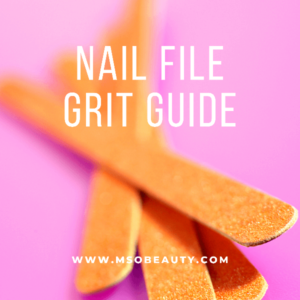You may have wondered how to soak off polygel nails with acetone like you always do with acrylic nails or gel nail polish.
The truth is You can’t soak off polygel nails with acetone alone.
This is because polygel is different from acrylic nails and gel nail polishes.
Polygel is a hybrid material that is made from acrylic powder and oligomers from hard gels.
The molecular structure of hard gels is very tight, and the molecular weight is quite low. Acetone can’t break down hard gel because of its rigid structure. That’s why you can only remove hard gel nails by filing them off.
Since polygel is similar to hard gels, it’s not a soakable product. So it needs to be filed off too.
However, if you’re afraid of damaging your natural nail plate with filing you can still use acetone for helping you to remove polygel nails and I’ll show you how to do it.

How to soak off polygel nails with acetone step by step
In short, you can’t soak off all polygel solely with acetone but you can reduce the length and the thickness of your polygel nails with a nail drill or a nail file.
After that, you can soak the remaining thin layer of polygel off with acetone.
This method lets you remove polygel nails safely without damaging the nail plate underneath.
For example, there’s no risk of digging into the nail plate too deep with a nail file or a nail drill if you leave a thin layer of material after filing.
And acetone will help you to get rid of that thin layer.
Here’s how to do it step by step:
1. Clip the extra length off
If your polygel nails are long you need to use nail clippers to get rid of the excess length.
Just clip all the nails down one by one.
You may need to apply more force than you do with other types of nail extensions because polygel nails are strong and long nails will be thick because of the apex curve of the dual forms.
Try to avoid cutting your natural nails in the process.
You can check where the natural nail ends if you turn the finger upside down while clipping your nails and look under the nail.
2. File the thickness down and reduce the remaining length
Next, you need to file down your polygel nails.
You can’t soak off that thickness with acetone alone because it will take forever.
And only breaking down the surface as you do with gel nail polishes before you soak them off is not enough either.
You’ll need to file the material down almost to the surface of your natural nail before you can soak the remaining polygel off with acetone.
You can use a nail drill to file polygel down. But if you don’t have a nail drill or aren’t too skilled with it don’t fret, you can do it with a nail file easily too.
It will just be quicker if you use a nail drill.
Using a nail drill
A nail drill is the fastest tool that you can use to remove the thickness and the remaining length of your polygel nails before you soak the residue off.
Nail drill
Take any nail drill that you normally use for filing acrylic or polygel nails. Just make sure it has a speed of more than 10K RPM, which all nail drills on the market usually have.
Nail drill bit
Get a bit with any shape that you prefer working with. The best ones for removing artificial nails are the barrel and conical bits.
You can use a carbide bit for removing polygel nails because these bits are strong.
Plus the bit won’t come in contact with your natural nail with this removal method.
But if you have a ceramic bit you can use it too.
Polygel is a thick material so you should use a coarse or a very coarse nail drill bit for removing it.
That means selecting a bit with green or even a black color code.
The black bit is the coarsest one and the green bit is slightly less coarse.
If you’re a beginner get the green bit because you may remove too much material and dig into the natural nail with the coarsest black bit.
Tip: use gentle stroking motions when filing down polygel. Avoid pressing the handpiece down or pushing your bit into the material too much.
Or using a nail file
Use a coarse emery board to take off polygel faster.
The grit level should be between 100 and 150.
It’s the best grit for removing polygel nails.
A higher grit will take more filing time and you’ll work slower.
However, when you’ve already filed most of the thickness down and got closer to the surface of your natural nail, switch to a higher grit. Get a 150/180 nail file.
Otherwise, you risk damaging the nail plate with a coarse nail file if you accidentally file the material down too much and reach the natural nail.
File polygel down
File the polygel down with a nail file or a nail drill until only a very thin layer of polygel remains.
When you get your polygel down to this thickness you can soak it off with acetone.
This hybrid filing+acetone removal method is great for people who are afraid to damage their natural nail plate by overfiling their polygel nails.
If you’re not too skilled with filing only reduce the thickness of your polygel nails and soak off the rest.
3. Soak off the remaining polygel with acetone
Now you can proceed to soak off your polygel nails.
Do it only when the layer of polygel on your nails has become very thin, otherwise, it will take forever.
It will still take a lot of time but at least it’s doable now.
Use the same process as when you’re removing acrylic nails or gel nail polish.
- Get 100% acetone nail polish remover, cotton disks, and aluminum foil.
- Soak cotton disks in acetone and place them on your nails.
- Wrap each nail with a piece of aluminum foil.
- Wait patiently, for at least 45-50 minutes or even more if necessary.
How much time will it take to soak off polygel nails with acetone?
You will need a lot of patience because it may take 45-50 minutes to soak off polygel nails with acetone, even when there’s only a thin layer of the material left on your nails. If the material is stubborn it may take even more time.
- Unwrap the nails.
- Try to scrape the remaining polygel off the nails with a cuticle pusher.
- The material won’t soften as acrylic nails do. It will just start falling off in hard chunks.
- Some of the material may remain stuck to the nail plate. If you’re having problems pushing it off you may need to put a cotton disk with acetone back on the nail, wrap it with foil again, and wait longer for it to get soaked off.
5. Buff down the residue
When all the material has soaked off there will still be a bit of residue left on your nails.
You’ll need to buff the residue down to get your nails rid of all the remaining polygel.
Use a 220/280 grit nail buffer for that.
Do it gently and avoid overfiling your natural nail plate’s surface.
To do it properly and to have more control over the nail file, keep buffing in one direction only and don’t file back and forth.
6. Apply cuticle oil
Since you’ve had to soak off your polygel nails with acetone for almost an hour your cuticles may become very dry.
So you’ll need to apply cuticle oil over all your cuticles to moisturize and soften them.
Can I soak off polygel nails with soap and water?
You may have seen some articles on the web that teach you how to soak off your polygel nails with water and soap.
This stuff is usually written by bogus nameless “nail techs/experts” and bad copywriters who have never seen polygel nails in real life.
As you can see, polygel nails are almost impossible to soak off with acetone and it takes literally forever to do that.
And if you try soaking them off with soap and water you’ll just waste your time.
Well, at least this useless method is totally safe and won’t be damaging to your nails or cuticles, plus it will help you wash your hands cleaner.
So no, you can’t soak polygel nails off with soap and water.
Recommended reading:
Best Polygel Nail Kit Reviews And How To Apply Polygel At Home
Best Glitter Polygel Nail Kits
Best And Safest Neon Polygel Nail Kits
Best Polygel Dual Forms For Perfect Nail Extensions
Is Polygel Bad For Your Nails? 9 Reasons Why It’s Safe
How To Dry Polygel Without A UV Light
Can I Use Water As A Slip Solution For Polygel?
Best Professional Gel Nail Polish Brands Used In Salons
Non-Toxic Gel Nail Polish Brands 101: Choose The Safest Gel Nail Polish
Best No Light Gel Polish — Gel Nail Polish Without UV Light
Best Small Salon Reception Desk For A Tight Space: Make An Amazing First Impression!











